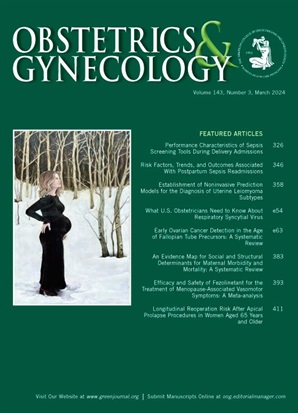Dating Discrepancies on Research Ultrasonography and Risk of Pregnancy Loss in a Prospective Cohort.
IF 4.7
2区 医学
Q1 OBSTETRICS & GYNECOLOGY
引用次数: 0
Abstract
OBJECTIVE To estimate the risk associated with discrepancies between last menstrual period (LMP)-based and ultrasound-based gestational dating and pregnancy loss in a prospective cohort of individuals of normal fertility who underwent standardized early-pregnancy ultrasonography. METHODS Participants in a community-based, prospective pregnancy cohort were recruited preconceptionally or in early pregnancy. Participants underwent standardized research ultrasonography targeted for the sixth week of gestation. We calculated the magnitude of lag between ultrasound-based age and LMP-based age at the research ultrasonogram. Cox proportional-hazards models were used to estimate the association between this difference and pregnancy loss. To assess for effect modification, analyses were stratified by week of research ultrasonogram, developmental features observed on the ultrasonogram, and menstrual regularity. RESULTS Among 4,935 participants, the median difference between LMP-based and ultrasound-based gestational age on the research ultrasonogram was 1 day (interquartile range -1 to 5 days), and 9.3% of pregnancies ended in loss. Risk of pregnancy loss increased exponentially with each additional day ultrasound-based dating lagged LMP-based dating (P<.001). This association persisted when stratified by week of ultrasonography and was more pronounced among pregnancies with a measurable crown-rump length. Ultrasound-based gestational age lagging LMP-based gestational age by more than 3 days was associated with a fivefold increased risk of pregnancy loss (adjusted hazard ratio [HR] 5.34, 95% CI, 4.37-6.52), and a lag of more than 5 days was associated with a greater than sixfold increased risk (adjusted HR 6.99, 95% CI, 5.78-8.44). These findings persisted when analyses were restricted to individuals with regular cycles and certain LMP dates. CONCLUSION Increasing lag between ultrasound-based dating and LMP-based dating among asymptomatic patients was strongly associated with pregnancy loss risk. This clinically quantifiable measure can inform concern for pregnancy loss before symptom onset among individuals with a certain LMP.在前瞻性队列中研究超声检查和妊娠丢失风险的年龄差异。
目的:在一组接受标准化早孕超声检查的正常生育个体的前瞻性队列中,评估基于末次月经(LMP)和基于超声的妊娠日期和妊娠丢失之间差异的风险。方法以社区为基础,前瞻性妊娠队列的参与者是在孕前或妊娠早期招募的。参与者在妊娠第六周接受了标准化的研究超声检查。我们计算了超声年龄和lmp年龄在研究超声图上的滞后幅度。Cox比例风险模型用于估计这一差异与妊娠损失之间的关系。为了评估效果的改善,根据研究周的超声图、超声图上观察到的发育特征和月经规律进行分层分析。结果在4935名参与者中,超声图上基于lmp和基于超声的胎龄的中位差为1天(四分位数范围为-1至5天),9.3%的妊娠以流产告终。超声测年滞后于lmp测年每增加一天,流产风险呈指数增长(P< 0.001)。当按周超声分层时,这种关联持续存在,并且在可测量的冠臀长度的妊娠中更为明显。超声胎龄落后于lmp胎龄超过3天与流产风险增加5倍相关(校正风险比[HR] 5.34, 95% CI, 4.37-6.52),延迟超过5天与风险增加6倍以上相关(校正风险比6.99,95% CI, 5.78-8.44)。当分析仅限于有规律月经周期和特定LMP日期的个体时,这些发现仍然存在。结论在无症状患者中,超声测年与lmp测年之间的时间差增大与流产风险密切相关。这种临床可量化的测量方法可以在症状出现之前告知患有某种LMP的个体是否担心妊娠丢失。
本文章由计算机程序翻译,如有差异,请以英文原文为准。
求助全文
约1分钟内获得全文
求助全文
来源期刊

Obstetrics and gynecology
医学-妇产科学
CiteScore
11.10
自引率
4.20%
发文量
867
审稿时长
1 months
期刊介绍:
"Obstetrics & Gynecology," affectionately known as "The Green Journal," is the official publication of the American College of Obstetricians and Gynecologists (ACOG). Since its inception in 1953, the journal has been dedicated to advancing the clinical practice of obstetrics and gynecology, as well as related fields. The journal's mission is to promote excellence in these areas by publishing a diverse range of articles that cover translational and clinical topics.
"Obstetrics & Gynecology" provides a platform for the dissemination of evidence-based research, clinical guidelines, and expert opinions that are essential for the continuous improvement of women's health care. The journal's content is designed to inform and educate obstetricians, gynecologists, and other healthcare professionals, ensuring that they stay abreast of the latest developments and best practices in their field.
 求助内容:
求助内容: 应助结果提醒方式:
应助结果提醒方式:


